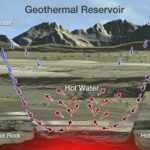Geothermal Energy


Geothermal energy is thermal energy generated and stored in the Earth. Thermal energy is the energy that determines the temperature of matter. The geothermal energy of the Earth’s crust originates from the original formation of the planet and from radioactive decay of materials (in currently uncertain but possibly roughly equal proportions). The geothermal gradient, which is the difference in temperature between the core of the planet and its surface, drives a continuous conduction of thermal energy in the form of heat from the core to the surface. The adjective geothermal originates from the Greek roots γη (geo), meaning earth, andθερμος (thermos), meaning hot.
Earth’s internal heat is thermal energy generated from radioactive decay and continual heat loss from Earth’s formation. Temperatures at the core–mantle boundary may reach over 4000 °C (7,200 °F). The high temperature and pressure in Earth’s interior cause some rock to melt and solid mantle to behave plastically, resulting in portions of mantle convecting upward since it is lighter than the surrounding rock. Rock and water is heated in the crust, sometimes up to 370 °C (700 °F).
From hot springs, geothermal energy has been used for bathing since Paleolithic times and for space heating since ancient Roman times, but it is now better known for electricity generation. Worldwide, 11,700 megawatts (MW) of geothermal power is online in 2013. An additional 28 gigawatts of direct geothermal heating capacity is installed for district heating, space heating, spas, industrial processes, desalination and agricultural applications in 2010.
Geothermal power is cost effective, reliable, sustainable, and environmentally friendly but has historically been limited to areas near tectonic plate boundaries. Recent technological advances have dramatically expanded the range and size of viable resources, especially for applications such as home heating, opening a potential for widespread exploitation. Geothermal wells release greenhouse gases trapped deep within the earth, but these emissions are much lower per energy unit than those of fossil fuels. As a result, geothermal power has the potential to help mitigate global warming if widely deployed in place of fossil fuels.